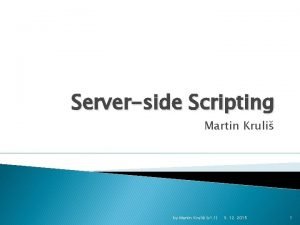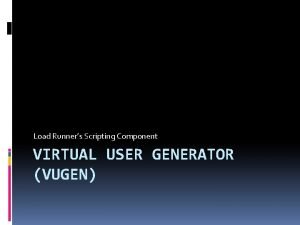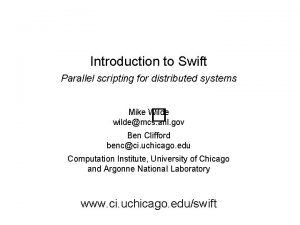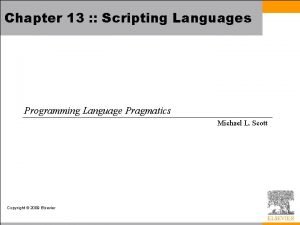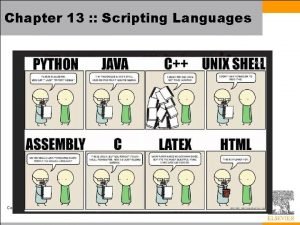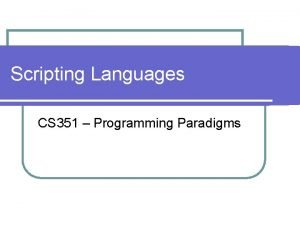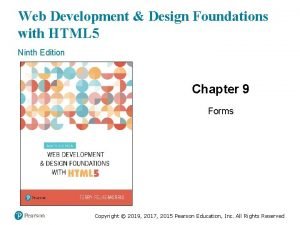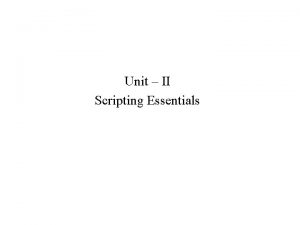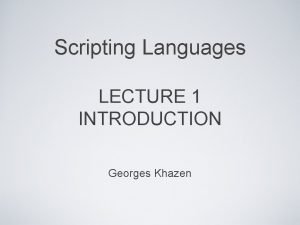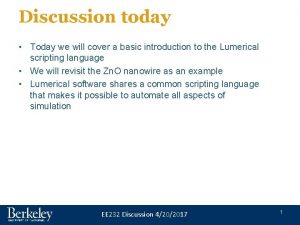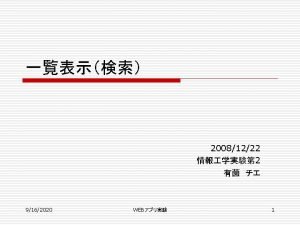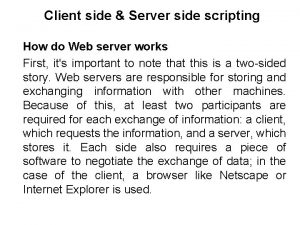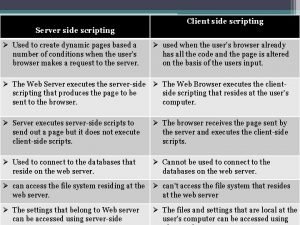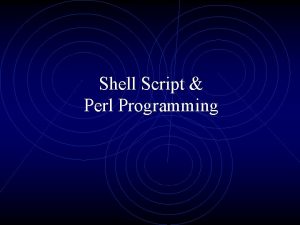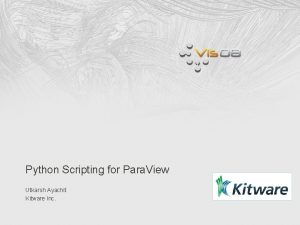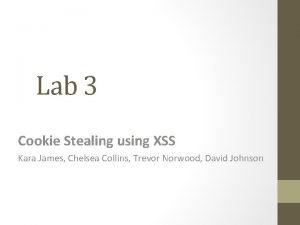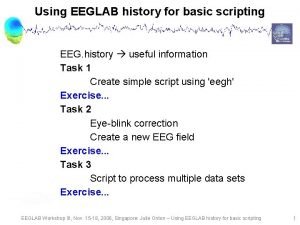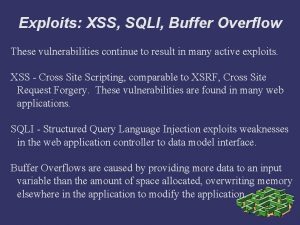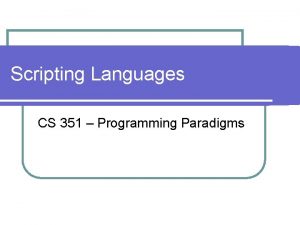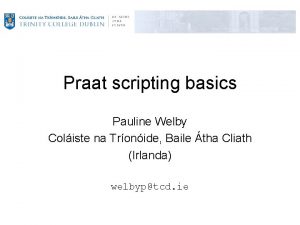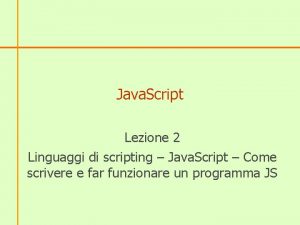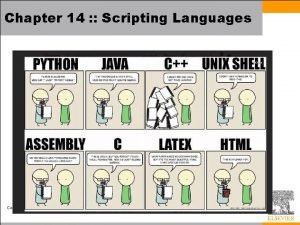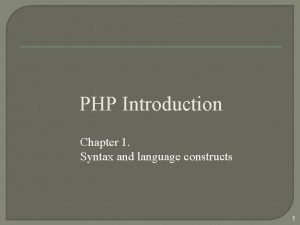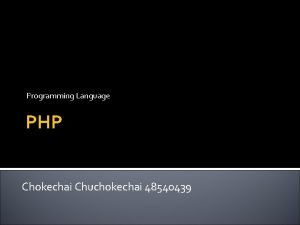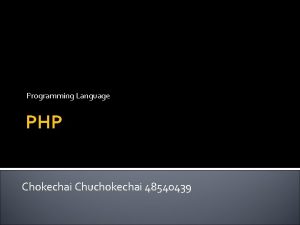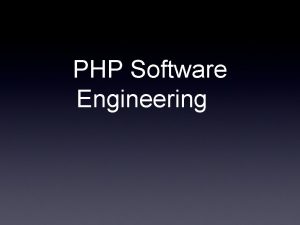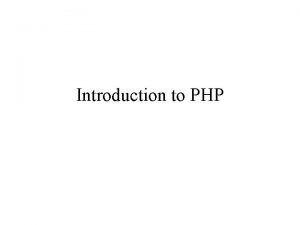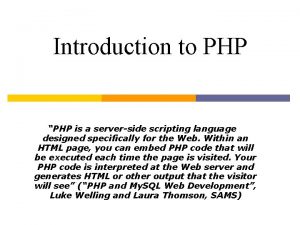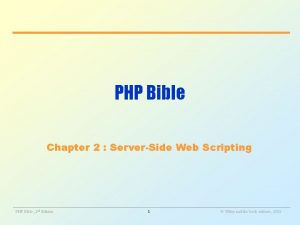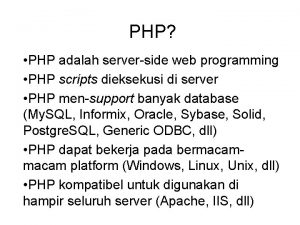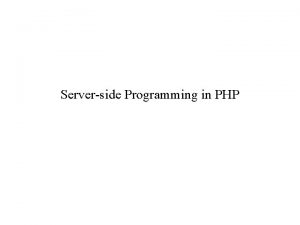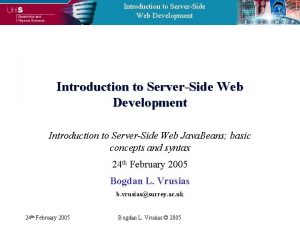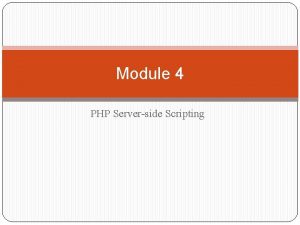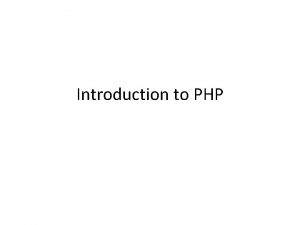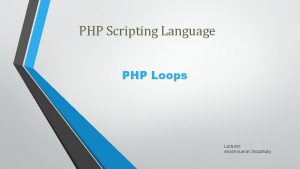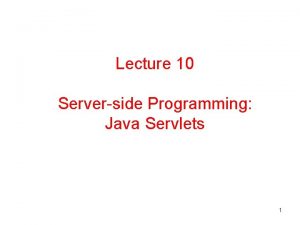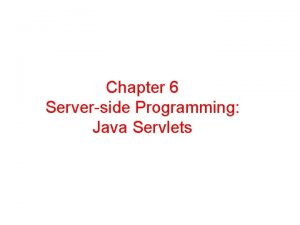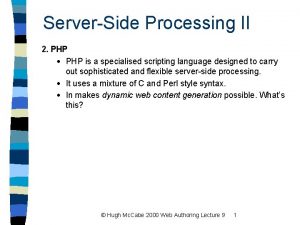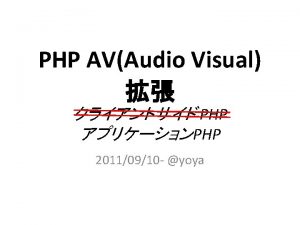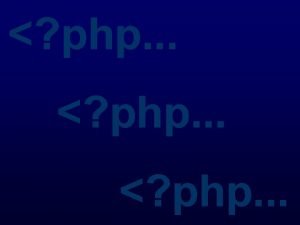Introduction to PHP PHP Serverside scripting language useful





















![Multi-Dimensional Arrays • To make multi-dimensional arrays just add more brackets: $arr[0][0]=1; $arr[0][1]=2; $arr[1][0]=3; Multi-Dimensional Arrays • To make multi-dimensional arrays just add more brackets: $arr[0][0]=1; $arr[0][1]=2; $arr[1][0]=3;](https://slidetodoc.com/presentation_image_h/308cdcbb6290b0e3e248c17777348e41/image-22.jpg)


![Foreach • Can use foreach on integer indices too: $arr[]="foo"; $arr[]="bar"; $arr[]="zot"; foreach ($arr Foreach • Can use foreach on integer indices too: $arr[]="foo"; $arr[]="bar"; $arr[]="zot"; foreach ($arr](https://slidetodoc.com/presentation_image_h/308cdcbb6290b0e3e248c17777348e41/image-25.jpg)























- Slides: 48

Introduction to PHP

PHP • Server-side scripting language useful for writing CGI • Began as online tools by Rasmus Lerfdorf – PHP = Personal Home Page tools – Bottom-up development, has become extremely popular today • • Somewhat like C but much higher level, OOP model was added later Especially with Apache/Linux/My. SQL Runs on both Unix and Windows platforms, with most web servers Used today with many commercial sites • Available for free – http: //www. php. net – Documentation and many resources available online • I prefer the online documentation, easy to search (several Mb as a single large HTML file)

Simple PHP Script • Consider the following HTML file, example. html: <html> <head> <title>My Page</title> </head> <body> <p>Hello world!</p> </body> </html>

Simple PHP Script • Here is an equivalent PHP script. PHP files have the extension “. php” and may contain both HTML and PHP code, which is enclosed inside <? php code ? > tags, or alternately <? code ? > (if supported) <html> <head> <title>My Page</title> </head> <body> <? php print(“<p>hello world!</p>”); ? > </body> </html>

Simple PHP Script • More interesting version, displays the date as known by the server: <html> <head> <title>My Page</title> </head> <body> <? php print(“<p>hello world! Timestamp: “. time(). “</p>”); ? > </body> </html> Could also use “echo” and () not required

PHP Time Stamp • The “. ” is used to concatenate strings • The server parses the document and interprets code within the <? php ? > tags instead of sending it directly to the client – i. e. you can write code to output the HTML you desire • Output of previous: hello world! Timestamp: 1050289182 Refresh two hello world! Timestamp: 1050289184 Seconds later:

PHP Script • Sometimes everything is placed inside the PHP tags. The following is equivalent; the header function specifies the MIME Type; i. e. that the document is HTML (as opposed to graphics, etc. ): <? php header("Content-Type: text/html"); print("<HTML><HEAD><TITLE>My Page</TITLE>"); print("</HEAD>"); print("<BODY>"); print("hello world! Timestamp: ". time(). "<p>"); print("</BODY></HTML>"); ? >

Identifiers and Data Types • Identifiers – Case-sensitive – Same rules as Java • Data Types – – booleans integer double string, surrounded by “ “ or by ‘ ‘ – Weak typing; you do not declare variables, just use them and the value assigned is the type of the variable; any old value is gone – Can typecast just like Java • (int), (double), (string), etc.

Variables • A variable is an identifier prefaced by $ • Example: $x = 1; $y = 3. 4; $z = $x + $y; $a = true; $s = "hello!"; print ($z. " ". $a. " ". $s); print "$z $a $s some other text here"; Output: 4. 4 1 hello! Note: true = non zero or not empty. False = 0 or the empty string “” Common novice mistake: Forgetting the $

Variables • Interpreted; consider the following: $x = 1; $y = “x”; print($$y); Output: 1 • Often {} are used to denote variable boundaries: $x = 1; $y = “x”; print(${$y});

Form Variables • If an HTML form invokes a PHP script, the PHP script can access all of the form variables by name • Invoking FORM: <form method=post action=“scr. php”> <input type=text name=“foo” value=“bar”> <input type=submit value=“Submit”> </form> • Inside scr. php: print($_REQUEST['foo']); // Outputs “bar”

Sample PHP Form <? php header("Content-Type: text/html"); print("<HTML><HEAD><TITLE>My Page</TITLE>"); print("</HEAD>"); print("<BODY>"); print("foo = ". $_REQUEST[‘foo’]. ", bar = ". $_REQUEST[‘bar’]. "<P>"); print("<form method=post action="example. php">"); print("<input type=text name="foo" value="zot">"); print("<input type=hidden name="bar" value=3>"); print("<input type=submit>"); print("</form>"); Note: ” escape character print("</BODY></HTML>"); Could also use ‘ instead ? >

Sample PHP Form • First load: • Upon submit:

Webbrowser • What the web browser receives after the first load. Note that we see no PHP code: <HTML> <HEAD><TITLE>My Page</TITLE> </HEAD> <BODY>foo = , bar = <P> <form method=post action="example. php"> <input type=text name="foo" value="zot"> <input type=hidden name="bar" value=3> <input type=submit></form></BODY></HTML>

Accessing Unset Variables • Depending upon the configuration of PHP, you may or may not get error messages when trying to access variables that have not been set • Can avoid this issue using isset: if (isset($_REQUEST[‘foo’], $_REQUEST[‘bar’])) { print("foo = ". $_REQUEST[‘foo’]. ", bar = ". $_REQUEST[‘bar’]. "<P>"); }

GET and POST • Another way to hide the printing of variables when the code is first loaded is to detect if the program is invoked via GET or POST <? php header("Content-Type: text/html"); print("<HTML><HEAD><TITLE>My Page</TITLE>"); print("</HEAD>"); print("<BODY>"); if ($_SERVER['REQUEST_METHOD'] == ‘POST') { print("foo = ". $_REQUEST[‘foo’]. ", bar = ". $_REQUEST[‘bar’]. "<P>"); } print("<form method=post action="example. php">"); print("<input type=text name="foo" value="zot">"); print("<input type=hidden name="bar" value=3>"); print("<input type=submit>"); print("</form>"); print("</BODY></HTML>"); ? >

Operators • Same operators available as in Java: +, -, *, /, %, ++, -- (both pre/post) +=, -=, *=, etc. <, >, <=, >=, ==, !=, &&, ||, XOR, ! • Some new ones === !== Identical; same value and type Not identical; not same value or type

Assignments • PHP will convert types for you to make assignments work • Examples: print(1 + "2"); // 3 print("3 x" + 10. 5); // 13. 5 $s = "hello". 55; print("$s<p>"); // hello 55

Arrays • Arrays in PHP are more like hash tables, i. e. associative arrays – The key doesn’t have to be an integer • 1 D arrays – Use [] to access each element, starting at 0 – Ex: $arr[0] = “hello”; $arr[1] = “there”; $arr[2] = “zot”; $i=0; print(“$arr[$i] whats up!<p>”); // Outputs : hello whats up!

Arrays • Often we just want to add data to the end of the array, we can do so by entering nothing in the brackets: $arr[] = “hello”; $arr[] = “there”; $arr[] = “zot”; print(“$arr[2]!<p>”); // Outputs : zot!

Array Functions • See the text or reference for a list of array functions; here are just a few: count($arr); sort($arr); array_unique($arr); // Returns # items in the array // Sorts array // Returns $arr without duplicates print_r($var); // Prints contents of a variable // useful for outputting an entire array // as HTML // Returns true if $val in $arr in_array($val, $arr)
![MultiDimensional Arrays To make multidimensional arrays just add more brackets arr001 arr012 arr103 Multi-Dimensional Arrays • To make multi-dimensional arrays just add more brackets: $arr[0][0]=1; $arr[0][1]=2; $arr[1][0]=3;](https://slidetodoc.com/presentation_image_h/308cdcbb6290b0e3e248c17777348e41/image-22.jpg)
Multi-Dimensional Arrays • To make multi-dimensional arrays just add more brackets: $arr[0][0]=1; $arr[0][1]=2; $arr[1][0]=3; . . etc.

Arrays with Strings as Key • So far we’ve only seen arrays used with integers as the index • PHP also allows us to use strings as the index, making the array more like a hash table • Example: $fat[“big mac”] = 34; $fat[“quarter pounder”]=48; $fat[“filet o fish”]=26; $fat[“large fries”]=26; print(“Large fries have “. $fat[“large fries”]. “ grams of fat. ”); // Output : Large fries have 26 grams of fat Source: www. mcdonalds. com

Iterating through Arrays with foreach • PHP provides an easy way to iterate over an array with the foreach clause: • Format: foreach ($arr as $key=>$value) { … } • Previous example: foreach($fat as $key=>$value) { print(“$key has $value grams of fat. <br/>”); } Output: big mac has 34 grams of fat. quarter pounder has 48 grams of fat. filet o fish has 26 grams of fat. large fries has 26 grams of fat.
![Foreach Can use foreach on integer indices too arrfoo arrbar arrzot foreach arr Foreach • Can use foreach on integer indices too: $arr[]="foo"; $arr[]="bar"; $arr[]="zot"; foreach ($arr](https://slidetodoc.com/presentation_image_h/308cdcbb6290b0e3e248c17777348e41/image-25.jpg)
Foreach • Can use foreach on integer indices too: $arr[]="foo"; $arr[]="bar"; $arr[]="zot"; foreach ($arr as $key=>$value) { print("at $key the value is $value "); } Output: at 0 the value is foo at 1 the value is bar at 2 the value is zot If only want the value, can ignore the $key variable

Control Statements • In addition to foreach, we have available our typical control statements – If – While – Break/continue – Do-while – For loop

IF statement • Format: if (expression 1) { // Executed if expression 1 true } elseif (expression 2) { // Executed if expression 1 false expresson 2 true } … else { // Executed if above expressions false }

While Loop • Format: while (expression) { // executed as long as expression true }

Do-While • Format: do { // executed as long as expression true // always executed at least once } while (expression);

For Loop • Format: for (initialization; expression; increment) { // Executed as long as expression true }

Control Example Counts # of random numbers generated between 0 -10 srand(time()); // Seed random # generator with time for ($i=0; $i<100; $i++) { $arr[]=rand(0, 10); // Random number 0 -10, inclusive } $i=0; while ($i<=10) { // Initialize array of counters to 0 $count[$i++]=0; } // Count the number of times we see each value foreach ($arr as $key=>$value) { $count[$value]++; } // Output results foreach ($count as $key=>$value) { print("$key appeared $value times. "); }

Output 0 appeared 9 times. 1 appeared 9 times. 2 appeared 11 times. 3 appeared 14 times. 4 appeared 6 times. 5 appeared 7 times. 6 appeared 8 times. 7 appeared 11 times. 8 appeared 5 times. 9 appeared 9 times. 10 appeared 11 times.

Functions • To declare a function: function_name(arg 1, arg 2, …) { // Code // Optional: return (value); } Unlike most languages, no need for a return type since PHP is weakly typed

Function Example: Factorial function fact($n) { if ($n <= 1) return 1; return ($n * fact($n-1)); } print(fact(5)); // Outputs 120

Scoping • Variables defined in a function are local to that function only and by default variables are pass by value function foo($x, $y) { $z=1; $x=$y + $z; print($x); } $x=10; $y=20; foo($x, $y); print(“$x $y<p>”); // Outputs 21 // Outputs 10 20

Arrays: Also Pass By Value • Arrays also are passed by value! function foo($x) { $x[0]=10; print_r($x); print("<p>"); } $x[0]=1; $x[1]=2; $x[2]=3; print_r($x); print("<p>"); foo($x); print_r($x); print("<p>"); Array ( [0] => 10 [1] => 2 [2] => 3 ) Array ( [0] => 1 [1] => 2 [2] => 3 ) Not changed!

Pass by Reference • To pass a parameter by reference, use & in the parameter list function foo(&$x, $y) { $z=1; $x=$y + $z; print($x); } $x=10; $y=20; foo($x, $y); print(“$x $y<p>”); // Outputs 21 20

Dynamic Functions • Functions can be invoked dynamically too, like we can do in Scheme – Useful for passing a function as an argument to be invoked later function foo() { print("Hi<p>"); } $x="foo"; $x(); // Outputs “Hi”

Classes & Objects • • • PHP supports classes and inheritance PHP 5 allows public, private, protected (all instance variables are public in PHP 4) Format for defining a class; the extends portion is optional class Name extends base-class { public var. Name; … function __construct() { //… code for constructor … public if not specified; name of class is old style } private function method. Name() { … code … } • To access a variable or function, use $obj->var (no $ in front of the var) • To access instance variables inside the class, use $this->var needed to differentiate between instance var and a new local var

Class Example class User { public $name; public $password; public function __construct($n, $p) { $this->name=$n; $this->password=$p; } public function get. Salary() { // if this was real, we might // look this up in a database or something return 50000; } } $joe = new User("Joe Schmo", "secret"); print($joe->name. " - ". $joe->password. "<p>"); print($joe->get. Salary(). "<p>"); Output: Joe Schmo - secret 50000

Inheritance • Operates like you would expect class foo { public function print. Item($string) { echo 'Foo: '. $string. '<P>'; } public function print. PHP() { echo 'PHP is great. '. '<P>'; } } class bar extends foo { public function print. Item($string) { echo 'Bar: '. $string. '<P>'; } } $foo = new foo(); $bar = new bar(); $foo->print. Item('baz'); // Output: 'Foo: baz' $foo->print. PHP(); // Output: 'PHP is great' $bar->print. Item('baz'); // Output: 'Bar: baz' $bar->print. PHP(); // Output: 'PHP is great'

Dynamic Binding class foo { public function print. Item($string) { echo 'Foo: '. $string. '<P>'; } } function my. Test($o) { print_r($o->print. Item("mytest")); } class bar extends foo { public function print. Item($string) { echo 'Bar: '. $string. '<P>'; } } $foo = new foo(); $bar = new bar(); my. Test($foo); my. Test($bar); // Output: Foo: mytest // Output: Bar: mytest

Static Variables class User { public static $master. Password; public function foo() { print self: : $master. Password; } } User: : $master. Password = “abc 123”;

Destructors • Called when there are no more references to the object function __destruct() { print "Destroying ". $this->name. "n"; }

Abstract Classes • Abstract classes cannot be instantiated; abstract methods cannot be implemented in a subclass abstract class Abstract. Class { // Force Extending class to define this method abstract protected function get. Value(); abstract protected function prefix. Value($prefix); class Concrete. Class 1 extends Abstract. Class { protected function get. Value() { return "Concrete. Class 1"; } // Common method public function print. Out() { print $this->get. Value(). "n"; } } public function prefix. Value($prefix) { return "{$prefix}Concrete. Class 1"; } }

Interfaces • Could have made an interface if we leave out the common method interface i. Foo { public function get. Value(); public function prefix. Value($prefix); } class Concrete. Class 1 implements i. Foo { public function get. Value() { return "Concrete. Class 1"; } public function prefix. Value($prefix) { return "{$prefix}Concrete. Class 1"; } }

Objects in PHP 5 • Assigning an object makes a reference to the existing object, like Java: $joe = new User("Joe Schmo", "secret"); $fred = $joe; $joe->password = "a 4 j 1%"; print_r($joe); // user Object ( [name] => Joe Schmo [password] => a 4 j 1% ) print("<p>"); print_r($fred); // user Object ( [name] => Joe Schmo [password] => a 4 j 1% ) print("<p>"); In PHP 4 it assigned a copy instead; use clone in PHP 5

Other items in PHP • Many others, but just a few… OOP features added in PHP 5 – Final – instanceof – Reflection – Namespaces – Serialization
 Cruli
Cruli Language
Language Linden scripting language
Linden scripting language Loadrunner scripting language
Loadrunner scripting language Parallelism in a modest proposal
Parallelism in a modest proposal Explain the innovative features of scripting languages
Explain the innovative features of scripting languages Innovative features of scripting languages
Innovative features of scripting languages Common characteristics of scripting languages
Common characteristics of scripting languages What is server side programming
What is server side programming Types of scripting languages
Types of scripting languages Strongly typed scripting language
Strongly typed scripting language Lumerical scripting language
Lumerical scripting language Www.facebook.com.php
Www.facebook.com.php Php php://input
Php php://input Informal e-mail
Informal e-mail Inventor scripting
Inventor scripting Lab 7-1: scripting in the bash shell
Lab 7-1: scripting in the bash shell Gel scripting
Gel scripting Advantages and disadvantages of client side scripting
Advantages and disadvantages of client side scripting Client-side scripting examples
Client-side scripting examples Itay braun
Itay braun Perl shell scripting
Perl shell scripting Business object interface
Business object interface Paraview python scripting
Paraview python scripting Kara james facebook
Kara james facebook Alleeg
Alleeg Common cause of buffer overflow cross-site scripting
Common cause of buffer overflow cross-site scripting Scripting image
Scripting image Scripting image
Scripting image Neoload scripting
Neoload scripting Java scripting
Java scripting Linear scripting framework
Linear scripting framework Microsoft agent scripting helper
Microsoft agent scripting helper Shifting script vorlage
Shifting script vorlage What is scripting
What is scripting Praat scripting tutorial
Praat scripting tutorial Jmp scripting
Jmp scripting Papercut print scripting
Papercut print scripting Papercut job ticketing
Papercut job ticketing Tokens in marketo
Tokens in marketo Linguaggi di scripting
Linguaggi di scripting Papercut print scripting
Papercut print scripting Innovative features of scripting languages
Innovative features of scripting languages Java reporting framework
Java reporting framework Php language constructs
Php language constructs Home.php?language=
Home.php?language= History of php programming language
History of php programming language History of php programming language
History of php programming language Php features and paradigms
Php features and paradigms
